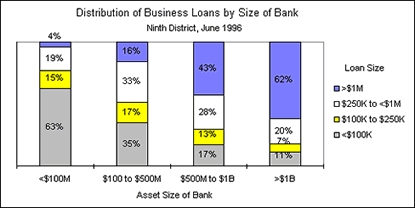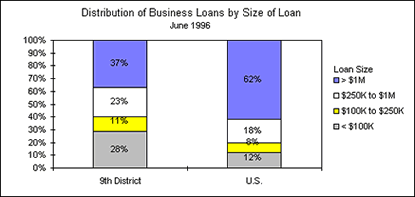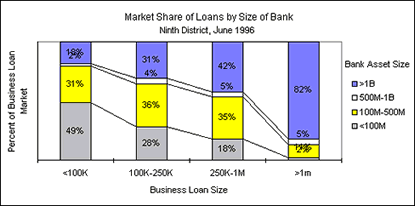Lending to small firms appears on the verge of transformation. Banks, especially large ones, have increasingly adopted a new application of technology called credit scoring to automate their small business lending. Credit scoring is a statistically based means of underwriting—evaluating the expected repayment performance of a loan—that can substantially decrease the time, human input and cost of reviewing applications. The shift could have particularly important implications for small banks that traditionally rely on small business lending.
One can best understand the larger implications of the new regime through analogy with a firm that is neither a bank nor a small business, Wal-Mart. Five years ago The Region reviewed how the rise of discount stores such as Wal-Mart altered the Ninth District's retailing landscape (see "Substance Before Style," September 1992). These firms provide a wide range of products at comparatively low prices while serving areas previously believed beyond mass marketers. They succeeded by adopting new information technologies, such as systems that identify and cheaply replenish profitable merchandise, and leveraging their massive scale. Both factors were critical in underpricing and outstocking other retailers.
Small business loans were also considered somewhat peripheral for many large lenders just as rural markets were outside the sights of large retailers. Large banks did not think they could apply automated lending to small businesses. But research into the relationship between the credit quality of owners and their small businesses has convinced some banks to score small business loans. Ultimately, credit scored small business loans could take on the general characteristics of credit card loans with their high volume, convenient distribution channels such as the mail and phone and high-tech assessment of risk.
Wal-Mart's efficient and technology-based retailing to smaller towns produced ambivalent feelings. Of course, mass discounters cannot attain growth and profitability without meeting the needs of consumers better than their rivals. Indeed, many small retailers charging full retail prices had difficulty competing with the national discounters and some towns lost many of their local merchants. Nonetheless, proprietors losing business of customers they believed loyal cannot avoid disappointment. More generally, the loss of local retailers has led some residents to conclude that the intangibles of small town life have been replaced by an inferior and sterile product.
Banks using credit scoring to increase their small business market share are not explicitly targeting borrowers of community banks. However, like Wal-Mart and small-town retailers, large banks recruiting existing small business borrowers will inevitably run into smaller banks. Banks with assets of less than $500 million held nearly 60 percent of all business loans under $100,000 even though they controlled only 18 percent of banking assets as of June 1996. (Data on small loans provides insight into small business borrowing because loan and borrower size are highly correlated.)
Like the small retailer, the smaller banks can meet the competition by differentiating themselves from larger banks that try to make small business loans a commodity. What about questions of community life? Will there be Wal-Mart like ambivalence? Do residents of small towns care if preapproved solicitations and calls to toll-free numbers replace face to face contact between borrowers and the local lender? A closer look at small business lending and credit scoring should inform the discussion of the broader questions the new technologies raise.
Small business lending by banks in the Ninth District and United States
Banks are extremely important providers of credit to small businesses. A recent analysis by the Federal Reserve found that banks provided a little over 60 percent of small business credit outstanding in 1993. But, is small business lending important to banks? Graph 1 indicates that smaller loans make up a significant minority of business loans (commercial and industrial loans and business loans secured by nonfarm, nonresidential property) made by banks nationwide.
Graph 1

Small loans make up a much greater portion of business lending by banks in the Ninth District. And the smaller the bank the larger the role of small business lending. Sixty-three percent of the business loans held by banks with less than $100 million in assets (about 85 percent of Ninth District banks at the time) were for under $100,000. In contrast, 62 percent of loans held by banks with assets greater than $1 billion were for over $1 million. Graph 2 provides additional detail on the distribution of business loans by the size of the loan and the bank. Small banks in the Ninth District, as with banks in the nation as a whole, hold a disproportionate amount of small business loans. Banks with assets of less than $500 million held 80 percent of all business loans under $100,000 despite controlling only 47 percent of district assets. Graph 3 provides additional detail on the business loan market share of banks according to the size of the bank and the size of the loan.
Graph 2

Graph 3

Why does business lending by small banks exhibit a heavy concentration of small business loans? Small businesses predominate in some locations, leaving a small bank with little opportunity to make larger loans. In addition, big loans could present too much of a risk for small banks. Banks need to diversify their portfolio in order to reduce the chance that the default of a single large borrower would expose the bank to catastrophic losses.
Small banks have also traditionally been considered better positioned to make loans to the local small business.
- The small bank may have better information on local business and economic conditions, through informal meetings and conversations with business owners for example, than larger banks without the same presence in the community.
- The small bank could have information on borrowers from activities in the savings and checking accounts that the small business maintains with the local bank.
- Both the bank and the small business benefit by continuing their relationship after an initial lending transaction. Economists with the Federal Reserve Bank of New York note that long-term borrowing arrangements, "... enable banks to collect information about the borrower's ability to repay, reducing the cost of providing credit. Borrowers, in turn, enjoy better access to credit and lower borrowing costs. Small banks make more of these 'relationship' loans than do large banks ..."
- Smaller banks can more flexibly apply their lending
criteria to small borrowers. It is harder for management at a
large bank with far flung operations to monitor the behavior of
loan officers. Large bank management may require that all loans
meet easily reported and observed financial tests as a result.
Loans approved by local staff that do not meet the financial ratios
wind up on special monitoring lists. This system may make local
staff loath to make loans that do not pass the hurdles established
by the central office. Management at a small bank can more easily
review and approve loans making it less necessary to implement
regimented standards.
The advantage of small banks over large banks is, in a word, information.
Credit scoring for small business loans turns this dynamic on its
head. Proponents of quantitative scoring argue that it provides
information on the future performance of the small business borrower
such that they can profitably extend credit to a firm even if bank
employees have never met the firms' principals.
Credit scoring small business loans
Credit scoring systems assign a single quantitative measure, or score, to a potential borrower representing an estimate of the borrower's future loan performance. Scores correlate with odds of the loan yielding "good" or "bad" performance. The definition of good and bad depends on the particular scoring system but, in general, a good loan meets banks' profit standards while a bad loan would not. Analysts developing scoring systems identify those characteristics of borrowers that best predict loan repayment. The developer then statistically assigns each of the characteristics a numerical weight so that the credit system measures the relative importance of a given characteristic in accurately forecasting repayment.
The outcome of these statistical procedures is a "score card" on which the characteristics of the borrower are noted and the score tallied. Analysts can derive scores from consumer credit bureau data such as a borrower's current level of indebtedness or previous repayment performance. Some scoring systems use credit bureau information supplemented with specific variables obtained from the loan application such as the size of the loan relative to the value of the object being purchased.
Credit scoring systems, however, are not like HAL, the all controlling
computer from 2001: A Space Odyssey. Most importantly,
the systems do not independently approve or reject a loan application.
The lender must decide how he or she will incorporate the credit
score into the loan review. The lender may decide to approve all
applications above a certain score, reject all loans below a lower
score and have a human underwriter review all loans that fall in
between the cutoff points. Many lenders have significant experience
in using credit scoring and making cutoff decisions become consumer
loans such as credit card and auto loans have been underwritten
with credit scores for decades.
Years of credit scoring would not seem at first blush to offer
much help in evaluating the credit quality of a business loan. Human
review and personal contact have long characterized business loan
reviews. Yet, in many cases the financial wherewithal and decision
making of the small business extend from the owner of the firm.
Therefore, the willingness and ability of the business owner to
repay personal borrowings could reasonably be assumed to correlate
with the ability and willingness of the firm controlled and managed
by the owner to repay its loans. Developers of scoring systems,
most notably Fair, Isaac and Co. Inc. (FICO), argue that their empirical
analysis of a large database of small business loans support this
observation. They found that the same variables determining the
owner's probability of loan repayment also determines a large part
of the credit score for the small firm.
FICO asserts that augmenting data on the owner of the firm with
very basic information obtained from a loan application and a business
credit bureau, such as past credit repayment experience collected
by Dun & Bradstreet, produces a reliable credit score. Perhaps more
importantly, FICO claims that data which had heretofore received
much scrutiny in the traditional underwriting process, such as ratios
from financial statements, are not crucial in determining the repayment
prospects of the small firm. In fact, FICO's most popular small
business scoring system does not require the small firm to provide
financial statements.
How could this seemingly technical change in loan review fundamentally alter the mechanics of small business lending?
- Lenders can extend credit to small businesses without any face to face contact by relying on third-party data. This makes lending to businesses in locations where a bank has no physical presence possible through means such as mailings of pre-approved applications. A Consumer Banker Association survey found that a quarter of respondents had mailed pre-approved small business applications in 1996 while almost no respondents had done so in 1992. Renewals, adjustments and administration of loans or lines of credit can take place over the phone.
- The documentation required of small business borrowers is greatly reduced. Applications for credit scored small business loans are often a single page.
- Credit scoring leads to much faster review. Lenders can underwrite a small business loan in minutes and close it within hours instead of days.
- A credit scoring based system could allow lenders to reduce their costs. Lenders could replace human underwriters with a combination of software and lower-paid data entry personnel. More generally, lenders often incorporate credit scoring in the reengineering and automating of lending. The retooling could cut costs, in part, by decreasing the amount of documentation produced, keyed into the system and reviewed. Banks capable of funding a large loan portfolio could also spread the fixed costs of computer or support systems for borrowers over a larger number of loans thereby reducing per loan costs. Wells Fargo, a leader in this field, made over 200,000 loans for $4 billion through its pre-approved small business program as of June 1996. They hope to make over $25 billion in such loans. A small bank could not benefit from anywhere near this level of activity.
- Banks could reduce loan losses if credit scoring provides a more accurate assessment of risk. Underwriters may also concentrate their reviews on the loans that require the most human attention under a credit scoring regime. Finally, scoring allows lenders to apply and change their standards in a more consistent fashion.
- A more quantitative assessment of risk may allow for loan pricing that better reflects the risk of the loan. Wells Fargo charges small firms loan rates ranging from the prime rate plus one percentage point to the prime rate plus eight percentage points (the prime rate as of the end of September was 8.5 percent). Banks using judgmental human reviews are not normally believed to differentiate pricing to this degree. Risk-based pricing may offer relief for high-quality borrowers who had previously been subject to fairly flat rates. While some credit scored loans may have very high interest rates, the borrowers who receive them may not have qualified for any credit under traditional underwriting.
- Automated underwriting and origination systems made possible by credit scoring may allow lenders to increase lending volume. Technology moves small business loan production toward mass and away from hand production. And credit scoring could make risk-based pricing a viable alternative to the rationing of credit.
These changes could dramatically modify the look and feel of small business loans. Borrowers could obtain and manage their small business loan like a run-of-the-mill credit card instead of filling out applications with details on financial performance and operating plans. With the changes in the small business loan may also come a transformation in the competitive environment to make these loans.
Competition for small business loans under the new technology
A long-run concern for banks has been the rise of alternatives to their mainstay products. Some large companies, for example, can obtain lower-cost financing by directly accessing securities markets instead of banks. Banks have sought out new markets to replace those they can no longer efficiently serve in order to maintain growth. The small business loan market offers large banks the opportunity to increase market penetration because of their relatively low existing share.
Lenders using the automated credit scoring approach could bring lower costs, a new ability to target and assess small business borrowers outside their areas of current operation, and an increased ability to make a large volume of small business loans in a short period of time. As one official from a large Pittsburgh bank that uses credit scoring noted, "If we are going to grow at the rate we want to, we have to go outside our geographic market. When we go to Kansas, we will have the lowest costs and go after the highest credit quality."
This large bank will not enter the heartland alone. The use of small business credit scoring has grown quickly, especially among large institutions. A survey of senior lending officers of larger banks by the Federal Reserve in early 1997 found that a little over 70 percent of respondents used a scoring system when making small business loans, with banks over $15 billion in assets most likely to use scoring. FICO reports that the vast majority of the leading small business lending banks use a credit scoring system. In the Ninth District, First Bank has moved to widespread scoring of their smaller business loans. Of course, nonbank lenders can also avail themselves of credit scoring. Nonbank firms like American Express, AT&T and the Money Store have targeted small business borrowers and could use the new technology in their efforts.
The entry of low-cost lenders into markets where small banks hold significant share should increase competition. A greater number of lenders competing for the current borrowers of small banks could lead small lenders to earn less than they would have otherwise on the small business loans they make. In particular, the lower cost providers could undercut the smaller lenders on credit extensions to the higher quality borrowers. By analogy, Wal-Mart could provide standard, brand name products at better prices than the local competition.
The credit scoring approach could also increase the number of competitors for small business borrowers by making it more feasible to sell groups of small business loans to investors. Investors have been reluctant to buy pools of small business loans because the variety of loan structures, underwriting and documentation makes it difficult to judge the pool's expected cash flows. Lenders may try to eliminate these differences in order to take advantage of the efficiencies offered by an automated underwriting and origination system. Investors ranging from pensions to individuals should willingly fund small business loans if they can buy interests in pools of homogenous small business loans with predictable cash flows. Small banks would then have to compete with international capital markets for small business lending.See discussion on some additional developments in the packaging and sale, or securitization, of small business loans.
Of course, no one can guarantee the success of small business credit scoring even if many banks move to these systems. Initial response rates to preapproved loan mailings have been quite low. It will take time before large banks make the most effective use of the new technology. In the interim, large banks face the often difficult and costly task of moving from an existing to a new lending process. And, new technologies always face the chance that they will perform much less satisfactorily than expected. The scoring systems may not predict loan outcomes as reliably as hoped, and banks may draw incorrect inferences from the information the systems provide.
Yet, there are some signs that big banks have gained advantage through credit scoring, although it remains far too early to declare it a long-term success. The amount of very small business loans (under $100,000) made by banks with assets over $5 billion increased by 16 percent from June 1995 to June 1996. These smaller loans are the most similar to personal loans of the business owner and are thus believed amenable to credit scoring. At the same time, other small business lending did not increase and loans for over $1 million increased by a little less than 3.5 percent. In contrast, large banks saw a huge increase in loans over $1 million and only a 4 percent increase in loans for under $100,000 from June 1994 to June 1995 when credit scoring was much less common.
The Federal Reserve banks in Kansas City and San Francisco recently reported similar trends in business lending by large banks in their regions and attribute them to credit scoring. Some analysts believe that market structure of small business lenders in the future will resemble the current credit card market because of the growing similarities in the production of the two types of loans. This transition would involve significant consolidation of small business lending as the top 10 credit card lenders control more than half of the market.
New competition and society's interest
The specter of increased competition has not been the normal concern raised in conjunction with large banks and small business lending. Policy-makers and bank advocates traditionally worry that large banks would take over smaller banks and curtail the amount of small business credit they made available locally (recent empirical research suggests that this fear is overblown). Should there be any concern about the movement away from the current norms of small business lending even when the amount of credit available to firms could increase?
The fate of the incumbent small banks, like that of smaller retailers facing Wal-Mart, depends on the behavior of local consumers and of the banks themselves. Local banks could ignore the potential threat and rely on the loyalty of existing customers. Such a strategy offers real risk in price-conscious times. Small banks could also try to retain market share by increasing their cost-cutting and lending efforts. These banks could facilitate cost cutting and growth through scoring systems offered by third-party vendors. However, the relatively limited number of businesses that community banks can serve and their inability to match the cost efficiencies, investment capabilities and supporting products offered by larger banks could limit the success of this option.
Small banks may have better luck by emphasizing and improving their traditional strengths of personal service and flexibility with borrowers. Communicating with their lender via mail and phone will not meet the needs of some borrowers. These borrowers will pay more for personal contact and advice offered by the small local bank. Moreover, some borrowers will want terms and conditions outside the standard contract offered by the large banks. In addition, lenders may not feel comfortable credit scoring the applications of certain firms on which reliable repayment data is not available. Smaller banks could compete for these non-conforming borrowers. The number of small business borrowers not eligible or not interested in the credit scored products will determine the success of these strategies.
No one knows the fate of the small business lender facing the new competition. But, we do know that full competition in lending makes it more likely that small firms can regularly access credit in the most effective manner. Surely the growth of one set of service providers at the expense of another can severely hurt specific lenders and individuals. Ultimately, however, ensuring that consumers are best served by efficient credit markets is more important than retaining a particular institutional form to lend to small firms, whether it be banks, finance companies or a completely new type of lender.
Where do communities fit into this consumer-oriented framework? One intangible of community commercial life has been the relationship between the local banker and the local small business. The new lending paradigm would cut that cord. Furthermore, it is possible that while individual firms consider their own costs and benefits when reviewing a loan offer, they do not account for the costs created when the larger community life that they favor is negatively impacted by their borrowing decision. As a practical matter, communities cannot prevent local firms from accessing outside-of-the-community sources of credit. Small towns cannot zone an offer from American Express to a small firm out of bounds as some were able to restrict the development of Wal-Mart stores. Those that believe the community impact should, but does not, affect decisions made by individual firms are left with the task of providing information such that these alleged costs are considered when small firms look for financing.





